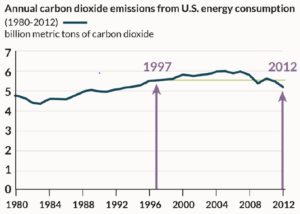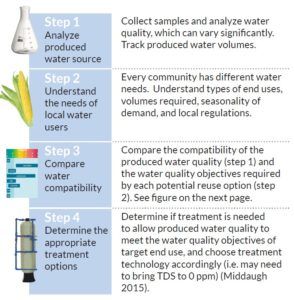Whoever Taught You Oil and Water Can’t Mix Was WRONG

Freeport-McMoRan Oil and Gas is leading the industry in using innovative methods to mitigate the impacts of climate change on water resources while continuing to quench America’s energy thirst.
Climate scientists largely agree that the global climate is warming due to greenhouse gas (GHG) emissions. There is also widespread consensus that emissions result primarily from burning oil, gas, and coal. I argue that the most devastating impacts of climate change will be associated with water, a vital resource for human survival. Warming temperatures will result in less precipitation and melting glaciers, and by 2030 water demand is forecast to exceed water supply by 40% (Henderson et al. 2016). While reducing GHG emissions is quintessential to abating climate change and the oil and gas industry must fundamentally change (or cease to exist), it is unrealistic to think that this can happen overnight. In the meantime, during my six-year career as an environmental impact consultant, I saw how Freeport-McMoRan Oil and Gas (FM O&G) is leading the industry in using innovative methods to mitigate the impacts of climate change on water resources while continuing to meet America’s energy thirst.
America’s Energy Thirst can’t be Quenched with Renewables Alone
First let’s agree that the oil and gas industry is here to stay, at least for a few decades. In 2015, 80% of American energy use was derived from fossil fuels. The Energy Information Administration (EIA) estimates that renewable sources will only account for 12% of America’s energy needs by 2040 (API 2015). Nonetheless, in 2012 the U.S. became the first major industrialized nation to meet its target for CO2 emissions proposed in the Kyoto Protocol, a 1997 international climate agreement devised to curb climate change. The largest drop in the U.S.’s emissions came from transitioning electricity generation from coal to natural gas (EIA 2013).
(Source: Catalyst Environmental Solutions 2016a)
Water Management Challenges
The rise in natural gas was possible due to the advent of hydraulic fracturing technology. Hydraulic fracturing is used to crack open vast reserves or natural gas that are tightly locked in rock formations miles beneath earth’ surface.
Along with hydraulic fracturing came water management challenges. Oil/gas production is referred to as a “skimming” operation because on average less than 10% of the liquid produced is oil/gas. The remainder is water. Every hydraulically fractured well can produced up to 1,000 barrels of water per day, decreasing over time as the well matures (CH2MHill 2015). This is a huge amount of water that has traditionally been viewed as a waste by-product and disposed of.
Water Crisis in California –> Identifying an Opportunity
During my career as an environmental consultant in California, I worked with Freeport-McMoRan Oil and Gas (FM O&G) to redefine oil field “waste” water as a new water source that can be used to help mitigate and adapt to the impacts that climate change is having on water supplies. California is currently in its fifth year of severe drought. The governor declared a drought state of emergency in 2014, and 2015 was the warmest year on record for California (USGS 2016). My team developed a simple four step process, outlined below, to identify how to beneficially reuse oil field waste water to mollify the drought strained region.
(Photo Source: Catalyst Environmental Solutions 2016b)
FM O&G’s Arroyo Grande Oil Field in the heart of California’s Central Valley wine region. My team interviewed local vintners and determined that they relied on groundwater for vineyard irrigation, but the groundwater aquifers were in overdraft. Demand was outstripping supply in the drought-strained system. We also identified that a stream running through the oil field, a critical habitat to the endangered steel-head species, was drying up because of the ongoing drought. By following the four-step process outlined above my team proposed treating the oil field “waste” water with a simple on-site system and recycling the water to replenish the local surface and groundwater resources (Middaugh et al. 2015) Following our recommendations, FM O&G is helping combat the local drought to the joy of the local vintners and steel-head.
Conclusion
It is obvious that to fully abate climate change oil and gas companies must revolutionize their business model as society transitions towards a more sustainable energy future (or they will cease to exist). In the meantime, FM O&G is innovatively proving that oil and water DO mix – oil field “waste” water can become an invaluable new water resource. In times of (climate change induced) water scarcity, wisely managing our water resources becomes critical, and the oil industry is helping lead the way.
(Word Count: 726)
Sources:
American Petroleum Institute. 2015. The State of American Energy: Energy Tomorrow.
Catalyst Environmental Solutions. 2016a. Untangling the Energy Mix. Prepared for American Petroleum Institute.
Catalyst Environmental Solutions. 2016b. Commitment to Beneficially Reusing Produced Water. Prepared for American Petroleum Institute.
CH2MHill. 2015. U.S. Onshore Unconventional Exploration and Production Water Management Case Studies. Prepared for the Energy Water Initiative.
Energy Information Administration (EIA). 2013. Monthly Energy Review: Energy-related carbon dioxide emissions declined in 2012. Available online at: http://www.eia.gov/todayinenergy/detail.cfm?id=10691
Henderson, Rebecca, S Reinhart, P Dekhtyar, A Migdal. Climate Change in 2016: Implications for Business. HBS N2-317-032.
Middaugh, Molly, D. Tormey, Ph.D., P.G., SPE, M. Schwartz. 2015. A New View of Produced Water: Resource, Not Waste. SPE-174049 -MS.
United States Geological Survey (USGS). 2016. California Drought. Available online at: http://ca.water.usgs.gov/data/drought/





This is an excellent short-term solution to a real-time technology development. Fracturing, as a relatively new technology, enjoyed a transitional period of reduced scrutiny of their waste. Now, as fracturing has increased across the states, it is being assessed for long-term advantages. I really like that this identified a problem and solution and all contained within a local area. It allows for very quick iteration and transportation of the water. Other considerations could include additional wastes of fracturing, as I understand it there are chemical implications involved, as well as the impact on environments. Vermont and New York have banned fracking already (http://www.nytimes.com/2014/12/18/opinion/gov-cuomo-makes-sense-on-fracking.html) if additional states join in will the efforts towards addressing fracking waste have gone in vain? Anyway, very excellent blog piece, tons of interesting specific data points and well-supported evidence.
Molly – Thank you for sharing a practical (and pragmatic) strategy for reducing the climate impact of fossil fuels! I agree that, especially in regions (California) where water is a scarce resource, re-using appropriately analyzed “waste” water in an environmentally thoughtful way is a fantastic idea. I’m curious as to your view of the go-forward commercial viability of water treatment and recycling systems throughout the U.S.
Navigant Research would suggest that this could be a $3.8 billion market by 2025 (http://www.businesswire.com/news/home/20160511005001/en/U.S.-Wastewater-Treatment-Recycle-Systems-Revenue-Expected). Do you see that market evolving? Is most of the value in particular treatment technologies? Testing? Or, in services (like your own) that structure the appropriate use of the water (taking into account the appropriate environmental circumstances)?